You are here
Democratic Republic of the Congo: A Migration History Marked by Crises and Restrictions

Refugee flows from the Democratic Republic of the Congo to neighboring countries, including Uganda, have increased in recent decades. (Photo: F. Noy/UNHCR)
The Democratic Republic of the Congo (DR Congo) is one of the most populous countries in sub-Saharan Africa, and the largest French-speaking African country. Since gaining independence from Belgium in 1960, the country and its 75 million residents have experienced numerous political and economic crises, including a war that claimed millions of lives. Although tremendously resource-rich, DR Congo remains one of the least developed countries in the world.
Protracted economic slumps and violent crises have profoundly affected Congolese migration trends. Once an attractive destination, especially for African migrants, DR Congo has been a country of outmigration since the early 1980s. Overall, emigration has increased, particularly toward neighboring countries, with inflows becoming less significant. At the same time, DR Congo’s social and economic deterioration has transformed the composition of its migration flows to extra-African destinations—with greater outflows of women, the less educated, and refugees and asylum seekers, particularly since the 1990s. In addition, with growing immigration restrictions in some destination countries and changing entry strategies, Congolese migration trajectories have become more complex, with new destinations attracting growing numbers of migrants.
Drawing on micro and macro data from the Migration between Africa and Europe (MAFE) and Determinants of International Migration (DEMIG) projects as well as other sources, this article surveys the changing patterns of Congolese migration over the last 50 years, examining how the shifting dynamics and characteristics of Congolese migration relate to changes in the economic and political contexts in the DR Congo and destination countries.
Figure 1. Map of the Democratic Republic of the Congo
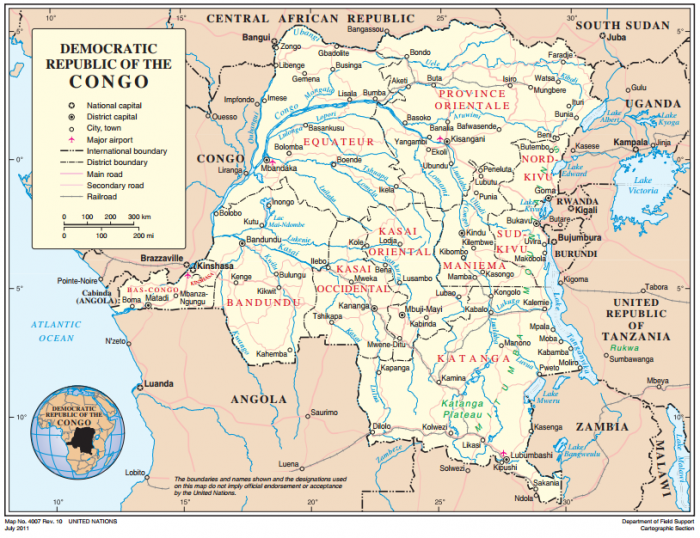
Source: United Nations, “Map of Democratic Republic of the Congo,” No. 4007 Rev. 10, July 2011, available online.
Historical Migration Flows
Historically a region of hunter-gatherers, the area now encompassed by DR Congo began experiencing migration thousands of years ago, with the centuries-long movement of the Bantu from West Africa and people known as Nilotes from what is now Sudan into Central Africa beginning around 500 BCE. More than 200 different ethnic groups were established in the Congo region by about 600 CE and by the 15th and 16th centuries had consolidated into a number of kingdoms and empires. Portuguese traders who arrived by ship in the late 15th century represented the first European contact. International migration in this period and the following centuries was driven by European exploration, missionary work, and expansion of the slave trade. An estimated 1.5 million people were ultimately taken as slaves from the Congo.
The King’s Colony
By the late 19th century, the European powers had begun to establish colonies across Africa. The relatively new country of Belgium, which gained independence from the Netherlands in 1830, sought to strengthen its status in Europe with an African colony. Following the 1885 Berlin Conference in which European states carved up Africa into colonial territories, the Congo Free State was founded as a personal colony of Belgian King Leopold II. While Leopold had argued for the humanitarian influence of Belgian rule, the Congo Free State was not intended as a populating colony, rather as one of resource extraction for its rich supplies of rubber, minerals, and oil. The Congo Free State government became notorious, however, for its abuse and exploitation of the local population, resulting in the death and maiming of millions. Under pressure from other European powers, the Belgian government took control of the territory in 1908.
Belgian migration to the Congo was limited during the Congo Free State period, with at most about 1,500 Belgians in-country in a given year. This population gradually increased to about 17,000 in 1930, and began to expand rapidly after World War II. On the eve of independence in 1959, nearly 89,000 Belgians lived in the colony, largely working as civil servants, missionaries, or employees of mining companies. Initially, Belgians comprised a minority of the foreign white population, accounting for 40 percent in 1890, as other Europeans worked as missionaries and for private companies. As the Belgian community grew, so did its share of the foreign population, reaching about 80 percent in 1959. Mass immigration to the colony was never encouraged, nor was Congolese migration to the metropole.
Internal and regional population movements within Congo, however, increased significantly during the colonial period as urbanization and movement to new towns, though strictly controlled, accelerated. Foreign mining companies also recruited thousands of workers from neighboring territories and colonies, such as Rwanda.
Independence
Congo gained independence in 1960 and the immediate postcolonial period was marked by the mass emigration of Belgians and forced local internal displacement due to secessionist conflicts. Despite the violence and political turmoil following the 1961 assassination of Patrice Lumumba, the Democratic Republic of the Congo’s first prime minister, and coming to power of Joseph Mobutu in 1965, the country’s economy remained fairly strong into the mid-1970s, due to exports of resources such as diamonds, uranium, and copper. Though widely known for rampant corruption and human-rights abuses, DR Congo (renamed Zaïre by Mobutu in 1971 until 1997) continued to draw economic migrants from throughout the region. With the 1973 oil crisis and global collapse in commodity prices, the country’s economy deteriorated greatly. Despite economic reforms and slight improvements, the situation had become critical by the late 1980s.
Migration in a Deteriorating Context
The 1990s constituted one of the darkest periods in DR Congo’s history. Growing dissatisfaction with the Mobutu regime and lagging democratization led to riots in 1991 in the capital, Kinshasa. In 1994, ethnic strife and civil war began spilling into DR Congo from neighboring Rwanda. The Rwandan genocide forced more than 1.2 million refugees across the Congolese border in July 1994. Among those who fled were remnants of Hutu militias who began crossborder attacks, prompting the Rwandan army to attack camps in DR Congo. Amid this instability, Laurent-Désiré Kabila launched an armed campaign against President Mobutu with the backing of Rwandan and Ugandan troops in the First Congo War (1996-97), deposing Mobutu after 32 years in power. A rebellion to depose Kabila began in 1998, starting the Second Congo War, which lasted until 2003. This conflict, which became known as Africa’s Great War, led to forced migration of refugees and more than 1.2 million internally displaced persons (IDPs). Following the 2001 assassination of Kabila, his son, Joseph, became president, a post he continues to hold.
Despite the war’s official end, the eastern parts of the country continue to experience regular violence and forced displacement. The political crises and wars throughout the 1990s contributed to rapid economic deterioration, driving further emigration. The economy has improved since 2003, and particularly since 2010, but living conditions remain extremely difficult.
Migration and Refugee Flows from DR Congo
DR Congo has long had both economic and humanitarian migration exchanges. African countries host the vast majority of Congolese migrants and refugees, whose numbers have increased significantly over the last four decades, particularly since the wars of the late 1990s and early 2000s. The lack of recent censuses in several destination countries (such as Angola) makes it difficult to precisely evaluate the distribution of Congolese migrants and changing patterns. Data from the United Nations Population Division nevertheless show significant changes over the last 25 years. In 1990, an estimated 300,000 Congolese migrants and refugees resided in one of the nine neighboring countries (Angola, Burundi, Central African Republic, Republic of Congo, Rwanda, Sudan [now South Sudan], Tanzania, Uganda, and Zambia), representing three-quarters of all migrants from DR Congo worldwide (see Table 1). Their number had more than doubled by 2000 (to approximately 700,000), and by mid-2015, had risen to more than 1 million in the neighboring countries (1.2 million for Africa as a whole; see Table 1).
Table 1. Stock of Congolese Migrants and Refugees in African Regions and Select Countries, 1990, 2000, and 2015
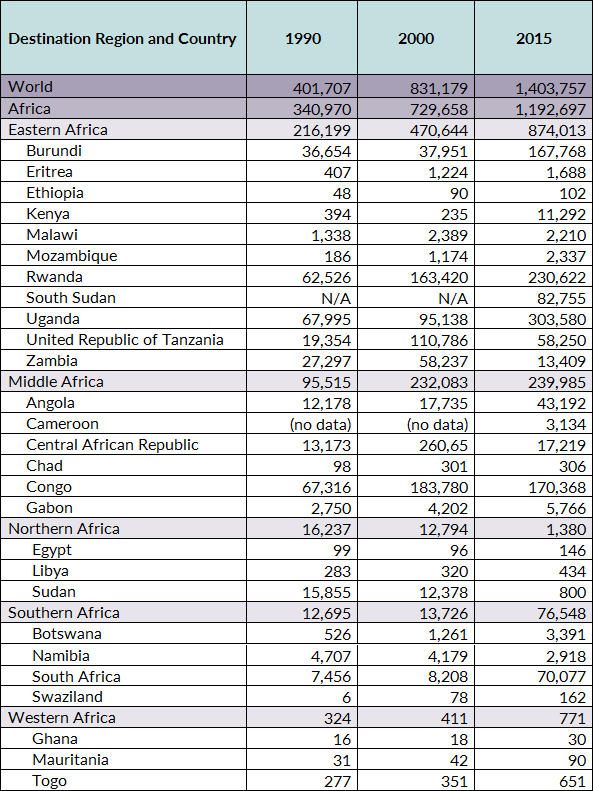
Note: Figures for 2015 are mid-year estimates. In most countries, figures refer to foreign-born populations, including refugees. In some countries, data refer to foreign citizens, or do not include refugees. No data are available for African countries that are not shown. Regional and global totals may be underestimated as data are not available in a substantial number of countries.
Source: United Nations Department of Economic and Social Affairs (UN DESA), “Trends in International Migrant Stock: Migrants by Origin and Destination,” 2015 Revision (United Nations database, POP/DB/MIG/Stock/Rev.2015), available online.
While political violence and lack of economic opportunities remain significant push factors, new opportunities in destination countries have also contributed to this growth. The end of the apartheid regime in South Africa in the mid-1990s boosted its desirability as a destination. And in the early 2000s, the end of the Angolan civil war, combined with unprecedented economic development, attracted many Congolese. The MAFE survey conducted in Kinshasa in 2009 also shows that migration rates from Kinshasa to African countries have markedly increased since the 1980s, much more so than to Western countries. South Africa and Angola alone received more than half of the migrants leaving the Kinshasa region in the 2000s.
Congolese refugee flows have also increased dramatically since the early 1990s. Approximately 80,000 refugees from DR Congo were living in neighboring countries through the mid-1990s; by the late 1990s, following the First Congo War and start of the Second, this number exceeded 250,000, according to the UN High Commissioner for Refugees (UNHCR). There were approximately 450,000 Congolese refugees in other African countries as of March 2016, UNHCR estimates. Most reside in Uganda (202,000), Rwanda (75,000), Tanzania (64,000), and Burundi (53,000). Internal displacement has also been widespread, reaching a peak of 3.8 million IDPs in 2008 and dropping to approximately 2.8 million as of March 2015, according to Internal Displacement Monitoring Centre (IDMC) estimates.
African Migration to DR Congo
In contrast, other Africans have been less prone to move to DR Congo. Recent data on international migrants in DR Congo are lacking, as no census has been conducted there since 1984. World Bank and UN Population Division estimates suggest a long-term decline in the presence of African migrants and refugees. More than 650,000 immigrants and refugees resided in DR Congo in 1990, according to UN Population Division estimates, most from neighboring countries (see Table 2); this number stood at more than 400,000 as of mid-2015.
However, refugee numbers fluctuate widely and sometimes rapidly in response to crises, as in 1994-95 after the Rwandan genocide that led to a peak of almost 2 million refugees. Around 250,000 Rwandan refugees still live in DR Congo, according to March 2016 UNHCR estimates. This figure is much higher than the overall number of Rwandese migrants and refugees estimated by the UN Population Division (Table 2), illustrating the uncertainty around these figures. Most recently conflict in the Central African Republic led to an influx of refugees, rising to more than 100,000 as of March 2016 according to UNHCR, and refugees from Burundi have also increased recently, reaching around 25,000 people in 2016. DR Congo was also host to several hundred thousand Angolan refugees displaced by that country’s 1961-75 war of independence and subsequent civil war. Most have returned through UNHCR repatriation programs since 2002, though a few hundred remain. Overall, the number of Congolese refugees abroad exceeds the estimated 400,000 foreign refugees in DR Congo as of March 2016, according to UNHCR estimates.
Table 2. Stock of African Immigrants and Refugees in DR Congo, 1990, 2000, and 2015
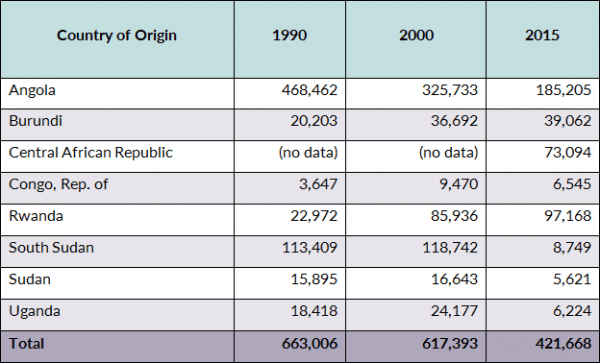
Note: Figures for 2015 are mid-year estimates.
Source: UN DESA, “Trends in International Migrant Stock,” 2015 Revision.
Non-African Migration to DR Congo
There has also been a stark decrease in immigrants originating from non-African countries in DR Congo between 1960 and 2000, as shown by the World Bank’s Global Bilateral Migration Database. This partly reflects the departure of colonial administrators and settlers after independence, as well as that of traders as conditions deteriorated. While European migrants predominated during the colonial period, Asians have become more numerous.
The presence of Asian nationals in the DR Congo is not new. Lebanese migrants have been present since the 1970s, working as traders, vehicle technicians, bakers, and restaurant owners. Around 6,000 Lebanese nationals were estimated to live in DR Congo in 2009, but few reliable data are available and the actual number may be higher. Indians operate businesses and have more recently invested in the mining sector, public transportation, and warehousing of Indian-made pharmaceutical products. According to the Indian Embassy in Kinshasa, 9,000 Indians and persons of Indian origin are living in DR Congo, not including the 5,000 or so Indian members of the UN peacekeeping operation in Eastern Congo (MONUSCO).
Chinese migration to DR Congo has also increased in recent years, as important contracts between Kinshasa and Beijing have been signed giving Chinese companies the right to operate many of DR Congo’s mines in exchange for helping develop the country’s road system and other infrastructure. Many Chinese workers came to provide labor in this context, working in mines and on infrastructure construction projects, and running businesses. According to China’s embassy, between 4,000 and 5,000 Chinese nationals lived in DR Congo in 2015. However, the actual number is probably higher; estimates in 2007 suggested up to 10,000 Chinese nationals were already living in DR Congo.
Changing Patterns of Congolese Migration to Western Countries
The presence of Congolese migrants in Western countries has increased in recent decades. Despite the colonial connection to Belgium, migration from DR Congo to Europe did not truly take off until the 1960s. At that time, most migrants were members of the country's elite who traveled to Belgium to study or for professional reasons, and returned to the Congo after completing their education or at the end of their mission. While Belgium has always imposed a visa for Congolese migrants, in the postcolonial era educated Congolese had certain opportunities to migrate to Belgium, for instance through university scholarships or professional sponsorship.
Increasing Migration to Western Countries and Diversification of Destinations
Several thousand Congolese migrants have arrived in Western countries each year over the last two decades (see Figure 2). Increases in these flows have been especially pronounced since the mid-1990s, when economic and political troubles in DR Congo intensified. However, this uptick was much less significant than that of outflows to other African countries, reflecting the higher costs of migration as well as tighter entry restrictions.
While Belgium was the main Western destination of Congolese migrants prior to the 1980s, destinations have increasingly diversified. France has become the preferred end point since the late 1990s (Figure 2), possibly as a result of greater ease getting visas and of obtaining asylum, and better labor market opportunities. Recent estimates indicate that France and Belgium together host more than 100,000 Congolese migrants, and that more than 50,000 others live elsewhere in Europe (including Germany, the Netherlands, Italy, and the United Kingdom; see Figure 2).
In addition to traditional migration flows, the number of Congolese asylum seekers in European countries also increased significantly since the late 1980s, fluctuating in response to crises in DR Congo (see Figure 3). Over the last 25 years, seeking asylum has become a particular immigration channel among Congolese migrants, together with family reunification and migration for education. MAFE surveys in Belgium and in the United Kingdom showed that since the 1990s, the proportion of asylum seekers among Congolese migrants has exceeded 50 percent.
Outside Europe, the United States and Canada have also become increasingly popular destinations since the 1990s (see Figure 2), each now hosting nearly 30,000 Congolese immigrants. This growing interest is also found among would-be migrants in surveys conducted in Kinshasa. Congolese migration to the United States has taken off since 2005, making the United States the second most popular Congolese destination outside Africa. Refugees and asylees represent a large share of Congolese obtaining permanent status in the United States, around 60 percent over the 2005-13 period). But the face of Congolese migration to the United States has been changing rapidly, with a growing share arriving via the diversity visa program (almost 40 percent of Congolese immigrants in 2013). Countries such as Australia have also recently started attracting Congolese migrants, but the flows have been much lower. While European destinations still appeal to Congolese migrants, restrictive immigration policies and difficulties integrating into the labor market may explain the emerging preference for other destinations.
In addition to direct migration from DR Congo to new locations, secondary migration has also contributed to the diversification of destinations. Beginning in the 1990s, substantial numbers of Congolese resettled in the United Kingdom from elsewhere, mainly France and Belgium. Congolese migration to North America also often takes place as secondary movement, from locations either in Africa or Europe.
Figure 2. Congolese Migration Flows to Selected Western Countries
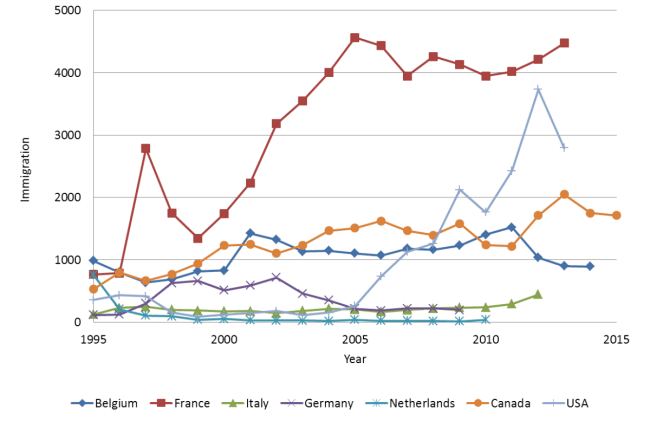
Note: The definition of immigration and data collection vary across countries. For instance, data in Canada and in the United States refer to the number of persons obtaining permanent resident status, while in France they correspond to the number of persons obtaining a residence permit of at least one year. These figures are thus not strictly comparable across countries, but provide indications of migration trends.
Source: Data up to 2009 for Belgium, Germany, Italy, and the Netherlands come from Oxford University, DEMIG C2C database, available online. Belgian data were updated up to 2014 with the National Register, and Italian data were updated from Eurostat database, “Immigration by sex, country of birth and broad group of citizenship,” available online. For France, data up to 1998 are from the DEMIG C2C database, and for 1999 to 2013, from d’Albis Hippolyte and Ekrame Boubtane, “Characteristics of Migration Flows to France Based on Residence Permit Data (1998-2013),” Population-E 20, no. 3 (2015): 487-523. U.S. data come from the Department of Homeland Security (DHS), Yearbook of Immigration Statistics (Washington, DC: DHS, various years), available online. Data for Canada are from Statistics Canada, “Canada - Permanent Residents by Country of Citizenship, 1980 – 2015,” available online.
Figure 3. Congolese Asylum Applications in Selected Western Countries
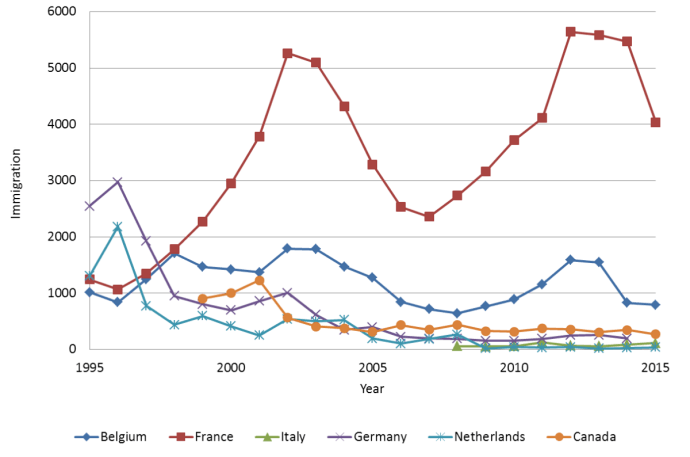
Source: United Nations High Commissioner for Refugees (UNHCR), “UNHCR Statistical Online Population Database,” data extracted April 9, 2014 and April 4, 2016, available online.
As a result of the diversification of flows, Congolese migrants now live in more countries than in the 1970s. All in all, more than 200,000 Congolese migrants live in Western countries, not counting asylum seekers and unauthorized migrants. Congolese migration to Asia, especially China, is also thought to be increasing but little information is available.
Table 3. Congolese Migrants living in Selected Western Countries, Various Years
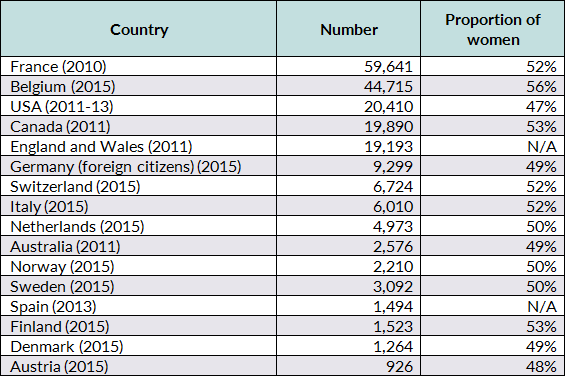
Sources: Unless otherwise stated, figures for European countries come from Eurostat database, “Immigration by sex, country of birth and broad group of citizenship,” available online; Australia: Census data from Department of Social Services, “Community Information Summary: Democratic Republic of the Congo-born” (2014), available online; Belgium: 2015 National Register; Canada: Statistics Canada, “2011 National Household Survey: Data tables,” available online; France: Institut National de la Statistique et des Études Économiques (INSEE), “Les immigrés par sexe, âge et pays de naissance - 2010,” available online; Germany: Statistisches Bundesamt, “Ausländische Bevölkerung: Ergebnisse des Ausländerzentralregisters” (2016), Table 3B, available online; United States: U.S. Census Bureau 2011-13 American Community Survey (ACS), available online; England and Wales: Office for National Statistics, “2011 Census: Country of birth (expanded), merged local authorities in England and Wales” (2014), available online.
Declining Return Migration from Western Countries
Prior to the 1990s, two-thirds of Congolese migrants in Europe returned within a decade. Today, most Congolese migrants in Western countries do not return. Whereas Congolese families used to encourage their children to return in the 1970s and 1980s, they now tend to push them to remain abroad, because of poor prospects in the labor market and high economic and political uncertainty. Anecdotal evidence suggests that returns may have increased recently among the better educated, as employment prospects and wages have improved for some categories of workers over the last few years. But return is not an option in the short term for many. As obtaining a visa for reentry to Europe has become more difficult, return jeopardizes the chances of departure in the event of new crises or difficulties reintegrating.
Feminization of Congolese Flows and Stocks
As returns have declined, the number of women migrating to Western countries has risen, in contrast with Congolese migration within Africa, which remains heavily male. The vanishing prospect of return has encouraged families to reunify in Western destination countries, leading to larger numbers of female Congolese emigrants. Emigration of single women has also increased, as well as migration for economic reasons among women, indicating more frequent autonomous movement. The share of females among Congolese migration flows to Canada, France, Germany, and the Netherlands has increased steadily since the 1990s, in some cases doubling or even overtaking that of males, as shown in DEMIG data. In most Western countries, Congolese women represent around half of the Congolese migrant population (see Table 3). MAFE survey evidence indicates Congolese women are also less likely than men to want to return. As a result, the percentage of women among Congolese migrants may continue to increase.
Changing Educational Profile of Congolese Migrants
In the 1970s and 1980s, Congolese migrants to Europe had overall high levels of education. In recent years, the share with higher education has greatly decreased. The opportunities for migration are still greater among the better educated, reflecting their greater economic resources, their relative advantage in obtaining a visa to pursue further education, greater social capital in destination countries, and the selectivity of destination-country admission policies. However, the educational profile of migrants to Europe began to change in the 1990s as a result of several factors. First, scholarship opportunities offered by both the Congolese and European governments were greatly reduced as bilateral relations were disrupted due to war and instability in the 1990s. At the same time, emigration became part of a strategy among Congolese families for increasing and diversifying sources of income, with low-income and lesser-educated migrants increasingly leaving the country. The growing share of asylum seekers—less educated than migrants arriving through traditional channels—as well as the feminization of migration flows contributed to the decrease in migrants’ education levels.
Looking Ahead
International migration to and from the Democratic Republic of Congo has undergone enormous change in recent decades, partly in response to political and economic crises in the country and in the region. Large flows of refugees, to and from DR Congo, as well as increasing migration flows to African and Western countries have characterized Congolese international migration over the last 30 years.
How will Congolese migration evolve? Political and economic conditions in DR Congo, though improving, have been unpredictable over the last decades, and their effect on future departures and returns is necessarily speculative. However, the recent development of the domestic and regional political context suggests that DR Congo may continue to experience substantial inflows and outflows of refugees in the coming years. The management of these flows, to and from DR Congo, will be a challenge for Congolese authorities and UNHCR, operating in settings with poor infrastructure and ongoing insecurity.
Migration flows to Western countries and returns are of course difficult to predict, but recent trends suggest the Congolese diaspora will keep growing rapidly, especially in new destinations such as North America. And, should a substantial improvement in the living conditions in DR Congo occur, it would not necessarily translate into less migration, as more development often leads to increased migration to developed countries. Moreover, the growing Congolese diaspora in Western countries may in turn fuel further Congolese emigration, facilitated by the presence of family and friends in destination countries. A challenge for DR Congo will be to develop, implement, and reinforce policies and initiatives to facilitate circulation and returns, and to stimulate remittances and investments by the diaspora. In destination countries, improving integration in the labor market—which remains difficult for a large share of Congolese in Western countries—will also be key to the well-being of migrants and their relatives in DR Congo.
This article draws on research from the Migration Between Africa and Europe (MAFE) and Determinates of International Migration (DEMIG) projects. The MAFE project received funding from the European Community’s Seventh Framework Programme under grant agreement 217206 (http://mafeproject.site.ined.fr/en/), and DEMIG received funding from the European Research Council under the European Community’s Seventh Framework Programme (FP7+/2007-2013)/ERC Grant Agreement 240940 (http://www.imi.ox.ac.uk/completed-projects/demig).
Sources
Agence France Presse and M&G Africa Reporter. 2015. Somalis in Soweto and Nairobi, Chinese in Congo and Zambia, local anger in Africa targets foreigners. Agence France Presse and M&G Africa Reporter, January 25, 2015. Available Online.
Australian Government, Department of Social Services. 2014. Community Information Summary: Democratic Republic of the Congo-born. Available Online.
Dika, Pierre-Paul. 2009. La politique d’immigration de la nouvelle Afrique du Sud post-apartheid [The Politics of Immigration in the New Post-Apartheid South Africa]. Paris: L’Harmattan.
d’Albis Hippolyte and Ekrame Boubtane. 2015. Characteristics of Migration Flows to France Based on Residence Permit Data (1998-2013), Population-E, 70 (3): 487-523.
Embassy of India, Kinshasa, Democratic Republic of Congo. N.d. India- DR Congo (DRC) Relations. Accessed March 12, 2016. Available Online.
Flahaux, Marie-Laurence. 2013. Retourner au Sénégal et en RD Congo. Choix et contraintes au cœur des trajectoires de vie des migrants [Return to Senegal and DR Congo. Choices and constraints in the heart of the life trajectories of migrants]. PhD thesis, Université Catholique de Louvain, Louvain-la-Neuve, Belgium, December 2013.
Flahaux, Marie-Laurence and Hein de Haas. 2015. African migration: trends, patterns, drivers, Comparative Migration Studies 4 (1): 1-25. Available Online.
Flahaux, Marie-Laurence, Cris Beauchemin, and Bruno Schoumaker. 2010. Partir, revenir: tendances et facteurs des migrations africaines intra et extra-continentales [To leave, return: Tendencies and factors in internal and extra-continental African migration]. Working Paper 7, Migration Between Africa and Europe (MAFE) project, Institut National D’Études Démographiques, April 2010.
Hesselbein, Gabi. 2007. The Rise and Decline of the Congolese State. An Analytical Narrative of State-Making. Working Paper no. 21, London School of Economics, Crisis States Research Centre, London, November 2007. Available Online.
Hugon, P. 2010. Les nouveaux acteurs de la coopération en Afrique [The new actors of cooperation in Africa], Dossier Afrique: 50 ans d’indépendance, Évolutions des politiques de développement, 1: 99-118. Available Online.
Internal Displacement Monitoring Centre (IDMC). N.d. Democratic Republic of the Congo IDP Figures Analysis. Accessed March 4, 2016. Available Online.
Kagné Bonaventure and Marco Martiniello. 2001. L’immigration subsaharienne en Belgique [Subsaharian immigration in Belgium], Courrier hebdomadaire du CRISP, 16/1721, CRISP, Bruxelles.
Lututala, Bernard Mumpasi. 2014. Intra- and Extraregional Migration in the South: The Case of Africa. In A New Perspective on Human Mobility in the South, Global Migration Issues 3, eds. Rudolf Anich, Jonathan Crush, Susanne Melde, and John O. Oucho. Geneva: International Organization for Migration and Springer.
Mangalu, Agbada. 2011. Migrations internationales, transfert des migrants et conditions de vie des ménages d’origine [International migration, migrant remittances, and living conditions in the origin household]. Cas de la ville de Kinshasa. PhD thesis, Université catholique de Louvain, Louvain-la-Neuve, Belgium, November 2011.
McCalpin, Jermaine O. 2002. Historicity of a Crisis – The Origin of the Congo War. In The African Stakes of the Congo War, ed. John F. Clark. New York: Palgrave Macmillan.
Meunier, Marianne. 2009. Afrique : la longue marche des Libanais [Africa: the long march of Lebanese], Jeune Afrique, October 13, 2009. Available Online.
Ndaywel è Nziem, Isidore. 1998. Histoire générale du Congo: de l'héritage ancien à la république démocratique [General History of the Congo: from the ancient heritage to the Democratic Republic]. Paris: De Boeck Supérieur.
Ngoie Tshibambe, Germain and David Lelu. 2010. Migration en République Démocratique du Congo: Profil national 2009 [Migration in the Democratic Republic of the Congo: National Profile 2009]. Geneva: International Organization for Migration. Available Online.
Ngoie Tshibambe, Germain and Mukohya Vwakyanakazi. 2008. Country Paper: The Democratic Republic of Congo. Oxford: International Migration Institute. Available Online.
Ngoie Tshibambe, Germain and Mukohya Vwakyanakazi. 2010. Migratory dynamics in the DRC: rationale and implications in Lubumbashi. Oxford: International Migration Institute, University of Oxford. Available Online.
Park, Yoon Jung. 2009. Chinese migration in Africa. Occasional Paper no. 24, South African Institute of International Affairs, China in Africa Project, Braamfontein, January 2009. Available Online.
Putzel, James, Stefan Lindemann and Claire Schouten. 2008. Drivers of Change in the Democratic Republic of Congo: The Rise and Decline of the State and Challenges for Reconstruction – A Literature Review. Working Paper no. 26, Crisis States Research Centre, London School of Economics, January 2008. Available Online.
Schoonvaere, Quentin. 2010. Etude de la migration congolaise et de son impact sur la présence congolaise en Belgique: Analyse des principales données démographiques [Study of Congolese migration and its impact on the Congolese presence in Belgium: Analysis of key demographics]. Brussels: Centre pour l’égalité des chances et la lutte contre le racisme. Available Online.
Schoumaker, Bruno and Marie-Laurence Flahaux. Forthcoming. Changing patterns of Congolese Migration. In Migration between Africa and Europe : Trends, Factors and Effects, ed. Cris Beauchemin. New York: Springer-Verlag and INED Population Studies series.
Schoumaker, Bruno, Eleonora Castagnone, Albert Phongi Kingiela, Andonirina Rakotonarivo, and Tiziana Nazio. Forthcoming. Congolese migrants’ economic trajectories in Europe and after return. In Migration between Africa and Europe: Trends, Factors and Effects, ed. Cris Beauchemin. New York: Springer-Verlag and INED Population Studies series.
Schoumaker, Bruno, Sophie Vause and José Mangalu. 2010. Political Turmoil, Economic Crisis, and International Migration in DR Congo: Evidence from Event-History Data (1975-2007). In Demographic Responses to Economic and Environmental Crises, eds. Satomi Kurosu, Tommy Bengtsson, and Cameron Campbell. Hikarigaoka, Japan: Reitaku University. Available Online.
Steinberg, Jonny. 2005. A Mixed Reception: Mozambican and Congolese Refugees in South Africa. ISS Monograph Series 117, Institute for Security Studies, Cape Town, South Africa, June 2005. Available Online.
Sumata, Claude. 2002. Migradollars and poverty alleviation strategy issues in Congo (DRC). Review of African Political Economy 39 (93-4): 619–28.
Sumata, Claude, Theodore Trefon, and Serge Cogels. 2004. Images et usages de l’argent de la diaspora congolaise: les transferts comme vecteur d’entretien du quotidien à Kinshasa [Images and usage of money by the Congolese diaspora: Remittances for the maintenance of the newspaper sector in Kinshasa]. In Ordre et désordre à Kinshasa: réponses populaires à la faillite de l’Etat [Order and disorder in Kinshasa: Popular responses to state bankruptcy], ed. Theodore Trefon. Tervuren, Belgium and Paris: Institut Africain and L’Harmattan.
Vause, Sophie. 2012. Différence de genre et rôles des réseaux migratoires dans la mobilité internationale des Congolais (RDC): étude des tendances, des déterminants et des conséquences de la migration [Gender differences and the role of migration networks in the international mobility of Congolese (DRC): The study of patterns, determinants and consequences of migration]. PhD thesis, l’Université catholique de Louvain, Louvain-la-Neuve, Belgium, 2012. Available Online.
United Nations Department of Economic and Social Affairs (UN DESA). 2015. Trends in International Migrant Stock: Migrants by Origin and Destination, 2015 Revision (United Nations database, POP/DB/MIG/Stock/Rev. 2015). Available Online.
UN High Commissioner for Refugees (UNHCR). N.d. Democratic Republic of the Congo – 2015 UNHCR Country Operations profile. Accessed March 4, 2016. Available Online.
---. N.d. DRC Regional Refugee Response – Information Sharing Portal. Accessed March 4, 2016. Available Online.
---. N.d. UNHCR Statistical Online Population Database. Data extracted April 9, 2014. Available Online.
---. 2007. Huge Country, Huge Problems – Huge Potential. Can DR Congo turn the page? Refugees 145 (1). Available Online.
---. 2014. Angolans head homewards by train from Democratic Republic of Congo. News release, August 19, 2014. Available Online.
Vanthemsche, Guy. 2012. Belgium and the Congo, 1885-1980. Alice Cameron and Stephen Windross, trans. Cambridge: Cambridge University Press.
Zong, Jie and Jeanne Batalova. 2014. Sub-Saharan African Immigrants in the United States. Migration Information Source, October 30, 2014. Available Online.


